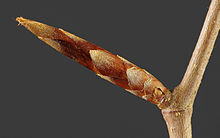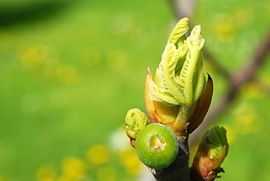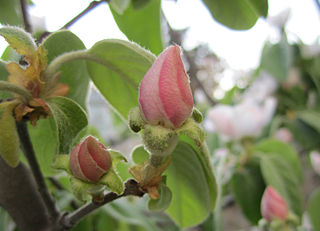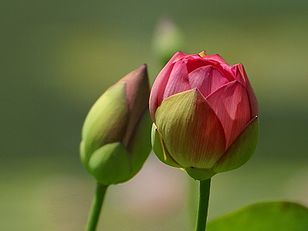কুঁড়ি
এই নিবন্ধটি বাংলায় অনুবাদ করা প্রয়োজন। এই নিবন্ধটি বাংলা ব্যতীত অন্য কোন ভাষায় লেখা হয়েছে। নিবন্ধটি যদি ঐ নির্দিষ্ট ভাষা ব্যবহারকারীদের উদ্দেশ্যে লেখা হয়ে থাকে তবে, অনুগ্রহ করে নিবন্ধটি ঐ নির্দিষ্ট ভাষার উইকিপিডিয়াতে তৈরি করুন। অন্যান্য ভাষার উইকিপিডিয়ার তালিকা দেখুন এখানে। এই নিবন্ধটি পড়ার জন্য আপনি গুগল অনুবাদ ব্যবহার করতে পারেন। কিন্তু এ ধরনের স্বয়ংক্রিয় সরঞ্জাম দ্বারা অনুবাদকৃত লেখা উইকিপিডিয়াতে সংযোজন করবেন না, কারণ সাধারণত এই সরঞ্জামগুলোর অনুবাদ মানসম্পন্ন হয় না। |

উদ্ভিদবিদ্যায়, কুঁড়ি বলতে একটি অপরিণত বা ভ্রূণ অঙ্কুর, কলি, মুকুল বা কোড়লকে বোঝানো হয়। সাধারণত পাতার অক্ষরেখায় বা কান্ডের ডগায় এটি তৈরি হয়। একবার গঠন হয়ে গেলে, একটি কুঁড়ি সুপ্ত অবস্থায় কিছু সময়ের জন্য থাকতে পারে বা এটি সঙ্গে সঙ্গে একটি অঙ্কুর তৈরি করতে পারে। কুঁড়ি ফুল বা ছোট অঙ্কুরে বিকাশে বিশেষায়িত হতে পারে। প্রাণিবিদ্যায়ও কুঁড়ি শব্দটি ব্যবহৃত হয়, যেখানে এটি শরীর থেকে বেড়ে উঠা এক ধরনের অঙ্গকে বোঝায় যা সম্পূর্ণ নতুন একটি জীবে পরিণত হতে পারে।
বিবরণ
[সম্পাদনা]
অনেক কাষ্ঠল গাছের কুঁড়ি, বিশেষত নাতিশীতোষ্ণ বা শীতল জলবায়ুতে কুঁড়িগুলো স্কেল নামে পরিচিত একধরনের পরিবর্তিত পাতা দ্বারা সুরক্ষিত থাকে যা কুঁড়ির সূক্ষ্ম অংশকে শক্ত করে ঘিরে থাকে। অনেকগুলি কুঁড়ি স্কেল একটি আঠালো পদার্থ দ্বারা আচ্ছাদিত করা থাকে যা অতিরিক্ত সুরক্ষাপ্রদায়ক হিসাবে কাজ করে। কুঁড়িগুলো বিকশিত হওয়া কালে স্কেলগুলো কিছুটা বড় হতে পারে তবে এগুলো সাধারণত ক্রমবর্ধমান কাণ্ডের পৃষ্ঠে অনুভূমিকভাবে দীর্ঘায়িত একরকম দাগ ফেলে দেয়। এই দাগগুলির মাধ্যমে যে কোনও তরুণ শাখার বয়স নির্ধারণ করতে পারা যায়, যেহেতু প্রতিবছর বৃদ্ধিতে একটি কুঁড়ি গঠন শেষ হয়। শাখার অবিচ্ছিন্ন বৃদ্ধির ফলে কয়েক বছর পরে এই দাগগুলি বিলুপ্ত হয়ে যায় বলে পুরানো শাখাগুলির মোট বয়স এই উপায়ে নির্ধারণ করা যায় না।
In many plants scales do not form over the bud, and the bud is then called a naked bud.[১] The minute underdeveloped leaves in such buds are often excessively hairy. Naked buds are found in some shrubs, like some species of the Sumac and Viburnums (Viburnum alnifolium and V. lantana)[২] and in herbaceous plants. In many of the latter, buds are even more reduced, often consisting of undifferentiated masses of cells in the axils of leaves. A terminal bud occurs on the end of a stem and lateral buds are found on the side. A head of cabbage (see Brassica) is an exceptionally large terminal bud, while Brussels sprouts are large lateral buds.
Since buds are formed in the axils of leaves, their distribution on the stem is the same as that of leaves. There are alternate, opposite, and whorled buds, as well as the terminal bud at the tip of the stem. In many plants buds appear in unexpected places: these are known as adventitious buds.[৩]
Often it is possible to find a bud in a remarkable series of gradations of bud scales. In the buckeye, for example, one may see a complete gradation from the small brown outer scale through larger scales which on unfolding become somewhat green to the inner scales of the bud, which are remarkably leaf-like. Such a series suggests that the scales of the bud are in truth leaves, modified to protect the more delicate parts of the plant during unfavorable periods.
কুঁড়ির প্রকারভেদ
[সম্পাদনা]

কুঁড়ির সাহায্যে প্রায়শই গাছ সনাক্তকরণ করা হয়, বিশেষত শীতকালে আবহাওয়াজনিত কারণে যখন গাছপালার পাতা ঝরে পড়ে।[৪] কুঁড়িগুলি বিভিন্ন মানদণ্ড (অবস্থান, স্থিতি, রূপচর্চা এবং ফাংশন) অনুসারে শ্রেণিবদ্ধ ও বর্ণিত হতে পারে।
উদ্ভিদবিদ্যার সাধারণত নিচের নামগুলো ব্যবহার করেন :
- অবস্থানের জন্য :
- terminal, when located at the tip of a stem (apical is equivalent but rather reserved for the one at the top of the plant);
- axillary, when located in the axil of a leaf (lateral is the equivalent but some adventitious buds may be lateral too);
- adventitious, when occurring elsewhere, for example on trunk or on roots (some adventitious buds may be former axillary ones reduced and hidden under the bark, other adventitious buds are completely new formed ones).
- for status:
- accessory, for secondary buds formed besides a principal bud (axillary or terminal);
- resting, for buds that form at the end of a growth season, which will lie dormant until onset of the next growth season;
- dormant or latent, for buds whose growth has been delayed for a rather long time. The term is usable as a synonym of resting, but is better employed for buds waiting undeveloped for years, for example epicormic buds;
- pseudoterminal, for an axillary bud taking over the function of a terminal bud (characteristic of species whose growth is sympodial: terminal bud dies and is replaced by the closer axillary bud, for examples beech, persimmon, Platanus have sympodial growth).
- for morphology:
- scaly or covered (perulate), when scales, also referred to as a perule (lat. perula, perulaei) (which are in fact transformed and reduced leaves) cover and protect the embryonic parts;
- naked, when not covered by scales;
- hairy, when also protected by hairs (it may apply either to scaly or to naked buds).
- for function:
- vegetative, if only containing vegetative pieces: embryonic shoot with leaves (a leaf bud is the same);
- reproductive, if containing embryonic flower(s) (a flower bud is the same);
- mixed, if containing both embryonic leaves and flowers.
চিত্রশালা
[সম্পাদনা]- বিভিন্ন ধরনের কুঁড়ি
-
অ্যালনাস গ্লুটিনোসা (Alnus glutinosa) কুঁড়ি
-
টিলিয়া (Tilia) কুঁড়ি
-
Black buds of a European ash, Fraxinus excelsior
-
An opening inflorescence bud at left, that will develop like the one to its right
-
সূর্যমুখী ফুলের একটি পুষ্পনিচয় কুঁড়ি
-
A quince's flower bud with spirally folded petals
-
নেলম্বো (Nelumbo) ফুলের ফুটন্ত কুঁড়ি
-
কোরিওপসিস টিনক্টোরিয়া (Coreopsis tinctoria) ফুলের ফুটন্ত কুঁড়ি
তথ্যসূত্র
[সম্পাদনা]- ↑ Walters, Dirk R., and David J. Keil. 1996. Vascular plant taxonomy. Dubuque, Iowa: Kendall/Hunt Pub. Co. page 598.
- ↑ Cronquist, Arthur, and Henry A. Gleason. 1991. Manual of Vascular Plants of Northeastern United States and Adjacent Canada. Bronx, New York: New York Botanical Garden Press. page 512.
- ↑ Coulter, John G. 1913. Plant life and plant uses; an elementary textbook, a foundation for the study of agriculture, domestic science or college botany. New York: American book company. page 188
- ↑ Trelease, W. (১৯৬৭) [1931], Winter botany: An Identification Guide to Native Trees and Shrubs, New York: Dover Publications, Inc, আইএসবিএন 0486218007







